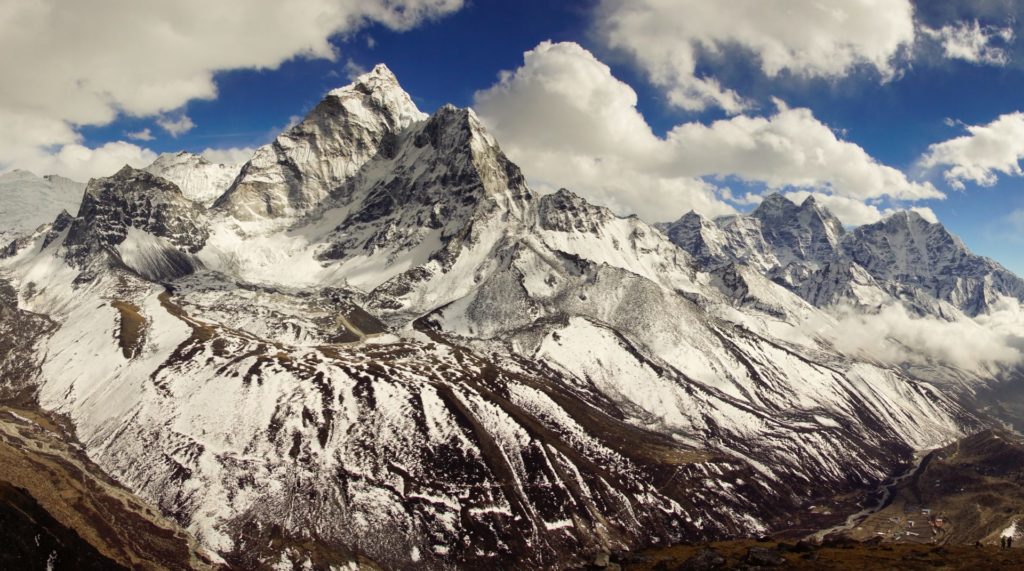- Sport & Abenteuer Reisen
- Klettern & Expeditionen
- Trekking Reisen
Overview
Trekking to Kala Patthar and Mount Everst Base Camp with option to climb Island Peak If you like to see Mount Everest up close, you’ve come to the right place! The trek to the world’s most famous base camp – Mount Everest Basecamp (EBC) – is one of the classics in Nepal. One of the highlights of this trek is the ascent of Kala Patthar. The Kala Patthar Black Stone with its 5,545 meters is a pre-peak of the Pumo Ri. From here – in the middle of the summit pantheon of Mount Everest, Mount Lothse, Mount Pumori, Mount Nuptse and many other 7,000-square-mile peaks – the view is simply indescribable – including the best view of Mount Everest. The trek begins with an adventurous flight in a small Fokker or Twin Otter to the legendary Tenzing-Hillary Airport in Lukla. From there, we continue to Namche Bazaar, the capital of the Sherpas, to the remote high mountain region of the Khumbu Glacier. It’s not just the snow-capped ice giants or the breathtaking landscapes that make this trek so extraordinary. Here you will meet an exciting culture, hospitality of the Sherpas, mysterious religions, mystical rituals, monasteries, stupas, holy men and a diverse flora and fauna. Option Island Peak The Island Peak Imja Tse with its 6,189 meters is a popular viewing peak in the Khumbu region. It lies between the Lhotse south wall and the Ama Dablam. Not to mention Mount Everest, which rises into the sky in the immediate vicinity. The Iceland peak is not technically very difficult, but it is also not a hiking peak. A 6,000-m tall mountain in the Himalayas requires a certain amount of mountaineering preparation due to altitude.
Program
Day 0 Departure from your home country
Day 1 Arrival in Kathmandu, altitude 1,300 meters
After arriving at Kathmandu Tribhuvan Airport, the trip goes to the hotel.
For the evening we invite you to dinner together in Thamel. Until then, the day can be spent at will. We recommend simply strolling through the old town of Thamel. At the dinner together, any questions that may remain unresolved will be resolved. The tour guide explains at this point the start of tomorrow’s tour and the tour schedule.
One night in a hotel, overnight stay with breakfast, 3 stars
Day 2 flight to Lukla, altitude 2,860 meters, then trek to Phakding, altitude 2,640 meters, 4 hours
Today is the time! The trek begins. The day starts with the trip to the domestic airport in Kathmandu. From there, take a small Twin Otter to Lukla at 2,840 meters. The flight time is about 45 minutes.
The flight to Lukla is already an adventure in itself. We recommend taking a seat on the left side of the machine. From there you have an optimal view of the mountains during the flight.
After landing, the tour starts with a breakfast in Lukla. The trek begins comfortably with a short descent to Kusumkosi, a side arm of the Dudhkosi , then along the Dudhkosi (“Milk River” or “White River”) leisurely to Phakding or on to Monjo (2 hours).
One night in the lodge/teahouse, full board
Uphill 150 meters
Downhill 300 meters
Distance 8 km
Day 3 Trek to Namche Bazaar, altitude 3,447 meters, 6 hours
The trail crosses the Dudh Koshi River twice and leads through some small villages to Jorsale. This is where Sagarmatha National Park begins.
There are about 650 meters of altitude on the way to Namche in front of us. With good visibility, the first view (shortly after the Hillarybrigde) on Mount Everest is already possible! The way up to Namche Bazaar is one of the harder sections of this trek, but with many small breaks along.
One night in the lodge/tea house, full board
Uphill 1150 meters
Downhill 300 meters
Distance 12 km
Day 4 Acclimatization Namche Bazaar, 3,437 meters, 4 hours hike
As of today, it is time to pause from the last ascents. We recommend a piece of warm apple strudel in the bakery.
But also in Namche you actually get everything that has come to mind on the way. Hats, gloves, sweaters, equipment, just to name a few. Today is all about height adjustment. After breakfast, a detour to the Everest View Hotel is the order of the day. Located at 3,850 metres, this hotel has a beautiful terrace with perfect views of the Khumburange. The view of many 7 and 8,000s like Mount Everest, Lhotse, Nuptse, Ama Dablam and many more, can be enjoyed wonderfully with coffee and cake!
Back to Namche, we go back to our lodge.
One night in the lodge/tea house, full board
Uphill 550 meters
Downhill 550 meters
Distance 8 km
Day 5 Trek to Tengboche, 3,770 meters, 6 hours
The trek begins today with the ascent to Syangboche. There it goes over the runway of Syangboche Airport. An attempt was made here until the end of the 90s to establish a regular airport (similar to Lukla). Due to the frequent occurrence of altitude sickness among passengers, operations were discontinued. Now only supply and ambulance transports end up there.
The trail leads us through the village of Sangnasa and on to Teshinga, from there down to the Dudh Koshi River to Phunki Drengka (3250 m). After a break we continue towards Tengboche. Tengboche is situated on a ridge, surrounded by the high Himalayan peaks.
Arriving in Tengboche, the large monastery, which is the core of this small village, catches the eye.
Tengboche Monastery has an eventful past. It was built very late in 1916 under Lama Guru. In an earthquake in 1934, it was almost completely destroyed but rebuilt directly. In 1989 it was burnt down to the foundations, but two years later it was restored with German help.
One night in the lodge/tea house, full board
Uphill 900 meters
Downhill 500 meters
Distance 15 km
Day 6 Trek to Pheriche, 4,243 meters, 5 hours
When the monks of the monastery blow into the horn at sunrise in the morning, it is time to get up. If interested, visitors can participate in the morning ceremony in the monastery. Even with little interest, most visitors go to the monastery in the morning, the mysterious trumpets and drum sounds make you curious and, because of their volume, let even the die hard late sleeper crawl out of the warm sleeping bag.
The dreamlike scenery of the Himalayan giants accompanies us today on the way.
One night in the lodge/tea house, full board
Uphill 700 meters
Downhill 300 meters
Distance 15 km
Day 7 Acclimatization in Pheriche, 4,243 meters, 4 hours
In order to ensure good acclimatization, a few excursions are made today. It goes up towards 4,700 meters.
There are a few beautiful viewpoints from which you can enjoy the mountains of Khumbu.
One night in the lodge/tea house, full board
Uphill 500 meters
Downhill 500 meters
Distance 6 km
Day 8 Trek to Lobuche, 4,930 meters, 6 hours
Today’s goal is called Lobuche. Lobuche is actually just a collection of a few lodges. From today, however, there are magnificent sunrises and sunsets in front of the mountain giants to marvel at. The view of the snow-capped mountain giants is magnificent. Lobuche is four kilometres from the nearest destination, Gorak Shep.
In the afternoon it is recommended to walk around the surroundings. Climb a few meters further before going to bed.
One night in the lodge/tea house, full board
Uphill 700 meters
Distance 12 km
Day 9 Day Stage Mount Everest Base Camp, 5,350 meters, 6 hours and back to Gorak Shep, 5179 m, 2 hours
Today’s destination is Everest Base Camp at 5,350 m. First, however, we go to Gorak Shep, the highest and permanently inhabited settlement in the Himalayas. It lies exactly on the edge of the height that is permanently acceptable to humans.
In the morning the ascent begins, the path follows the Khumbu Glacier towards Gorak Shep and finally crosses it. After about 2.5 hours Gorak Shep is reached. After lunch we continue to the legendary Everest Base Camp, from where the Everest expeditions start to the summit and the Khumbu Icefall.
After a break we return to Gorak Shep.
One night in the lodge/tea house, full board
Uphill 650 meters downhill 400 meters
Distance 12 km
Day 10 Day Stage Kala Patthar, 5,545 meters, 4 hours and on to Lobuche, 4,930 meters, 4 hours
The night in Gorak Shep is short. Before sunrise, around 3:30 a.m., you should make your way to Kala Patthar. You should not miss the light play of the rising sun in the Khumbu. If you don’t want to get up so early, you can also watch the sunset from Kala Patthar. From the top of Kala Patthar (black stone) you have the perfect view of the highest mountains of the world. The Mt. Everest, Lhotse, Nupse, Ama Dablam, Changste. All stand before you and rise into heaven.
Back from Kala Patthar, with 1000 impressions in your luggage, the night is spent in Lobuche. The joy of exchanging a warm oven and the experience will be great.
Uphill 400 meters downhill 650 meters
Distance 16 km
Day 11-14 Extra: Day stage Island Peak Summit, altitude 6,189 meters
Option Island Peak:
If you want to and have time, you can climb the 6,189 meter high Island Peak on this tour. The detour would take three extra days.
Day 11: In the morning a comfortable trek back to Dingboche is planned. Here you can take a lunch break before continuing to Chhukung in just under three hours.
Day 12: The base camp of Island Peaks is only about three hours away from Chhukung, the day can be approached easily and if you feel like it, you can make small excursions (Imja Tse or Chhukung Ri). The team sets up the camp at Base Camp and prepares the food in the camp.
Day 13: Today the 6,000 mark is broken, the 6,198 meter high Island Peak is waiting for you. You have to leave early to make the stage of the day.
First, the trail leads over rough terrain to the beginning of the fissile glacier. Over this you can reach a steep flank with some upswings. The final ascent over short, fixed-rope-insured steep upturns to the summit (6,189 m) offers fantastic views of Lhotse South Face and Makalu (8,485 m). Descent to Chhukung.
Day 14: Reserve day for bad weather or other delays.
Accommodation in the Lodge/Tea house (Chhukung)/Tent Camp (Base camp), Full Board
Day 11/15 Trek to Thengboche, 3,770 meters, 5 hours
The road to Thengboche is no more than a long walk. It starts the same way back to the final moraines to Dughla, In the afternoon Tengboche is reached.
One night in the lodge/tea house, full board
Uphill 150 meters
Downhill 1300 meters
Distance 14 km
Day 12/16 Trek to Namche Bazaar, 3,447 meters, 6 hours
Downhill, Namche Bazaar should be reached comfortably around noon and the trail can still be continued to Monjo today (depending on condition and mood). The way to Namche is easy! It almost just goes downhill along the river. Once in Namche, there is everything your heart desires, the warm shower, pizza, cakes and everything you missed on the way. You will have a different view of these things. Enjoy the time.
One night in the lodge/tea house, full board
Uphill 200 metres
Downhill 680 meters
Distance 15 km
Day 13/17 Trek to Lukla, 2,860 meters, 7 hours
Today the way back to Lukla is planned, in theafternoon the lively place with the legendary airport is reached.
This was the last day of trekking of this trip. Tomorrow, with a little wistfulness, we will go back to civilization – to Kathmandu. One night in the lodge/tea house, full boardUphill 600 meters
Downhill 1300 meters
Distance 20 km
Day 14-17/18-21 Flight to Kathmandu and days in Kathmandu, 1300 m
If flights from Lukla to Kathmandu are on time, the next few days will be free. If you feel like, you can experience a lot of cultural and sightseeing in Kathmandu.
The three royal cities of Bhaktapur, Patan and Kathmandu with their medieval town centres as well as the most important Hindu and Buddhist sanctuaries in the kathmandu valley: Pashupatinath and Bodnath to name a few.
Three nights in a hotel, overnight stay with breakfast (breakfast), 3 stars
Day 17/21 Day of departure
Car/Taxi 1:00 hours travel time in private car or taxi
Pick up at your hotel and drive to the airport
Services
General
- A dinner together to get to know and prepare the tour
- All fees and permits for entry to the national parks
Transfers
- Flight from Kathmandu to Lukla
- Flight from Lukla to Kathmandu
Accommodation/catering
- All nights in the lodges/camps during the trek with breakfast/lunch/dinner
- Hotels in Kathmandu
Staff
- Min. an experienced English-speaking mountain guide
- Carriers during the trek
Not included
DrinksVisaInternational flightExcursion program Kathmandu (We are happy to support you with the organization)Tip for your crew if you like ittechnical climbing equipment for the Island Peak ascent- Can be rented for about 100 € in the Chhukung
Highlights
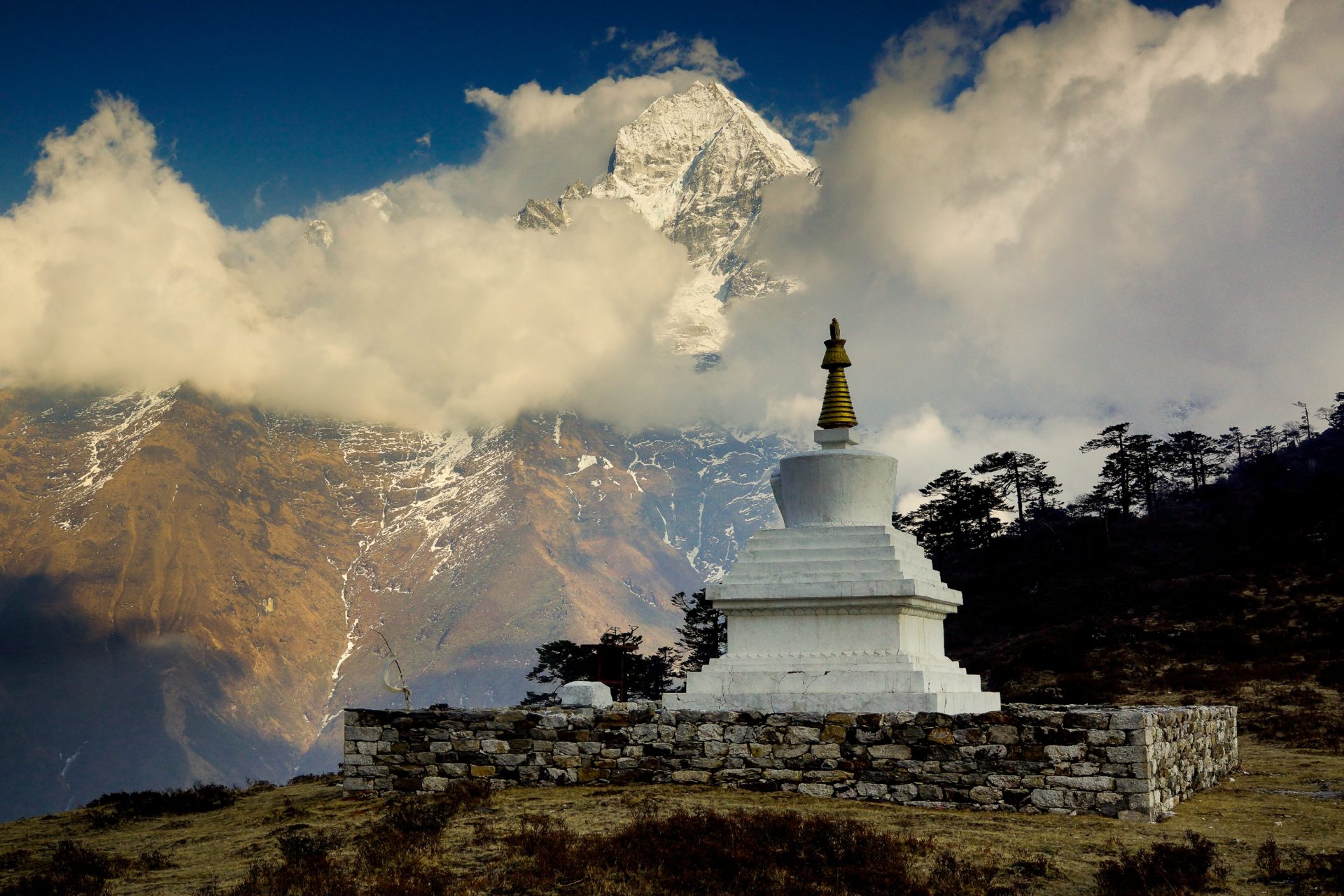
Everest Basecamp Trek 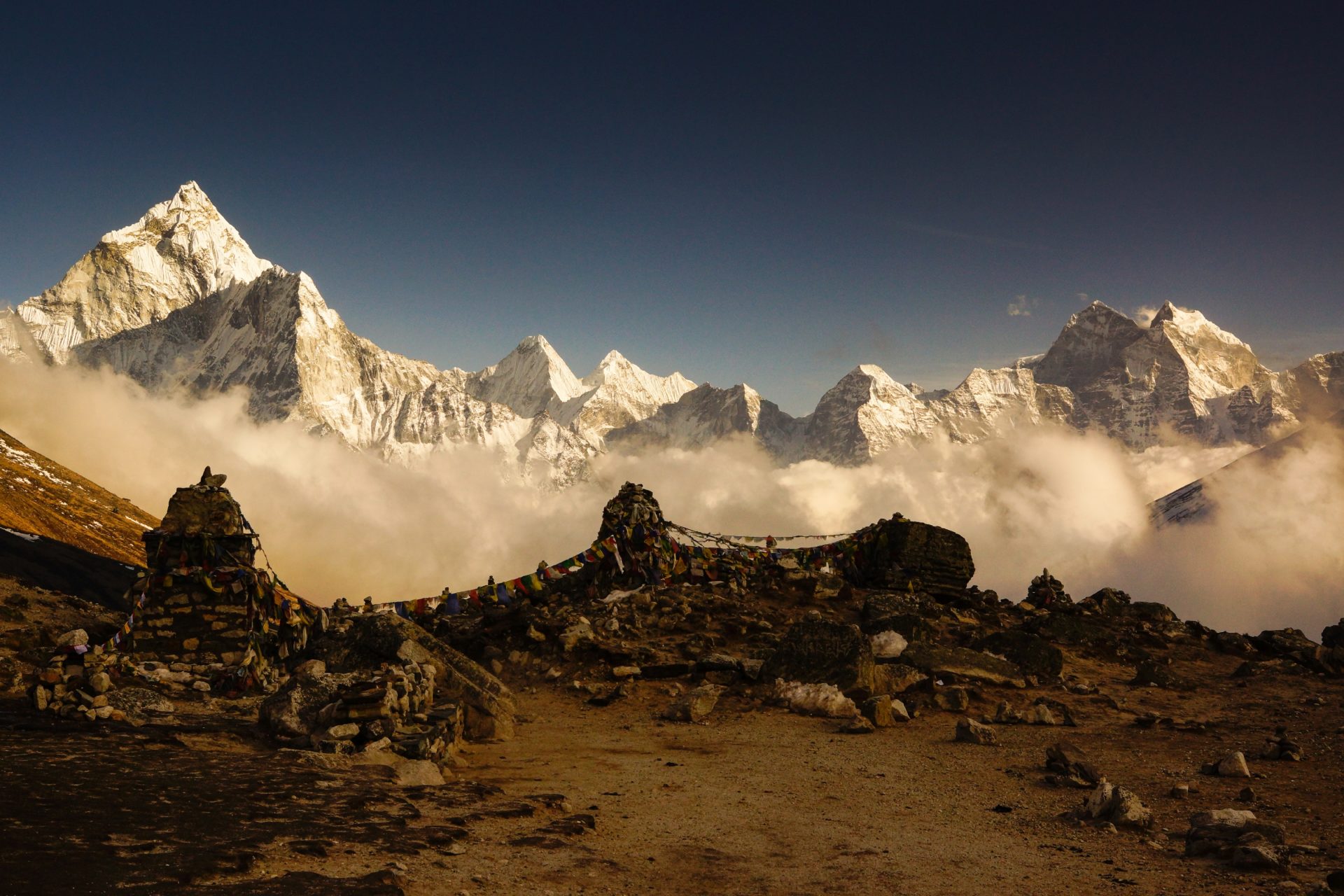
Everest Basecamp Trek 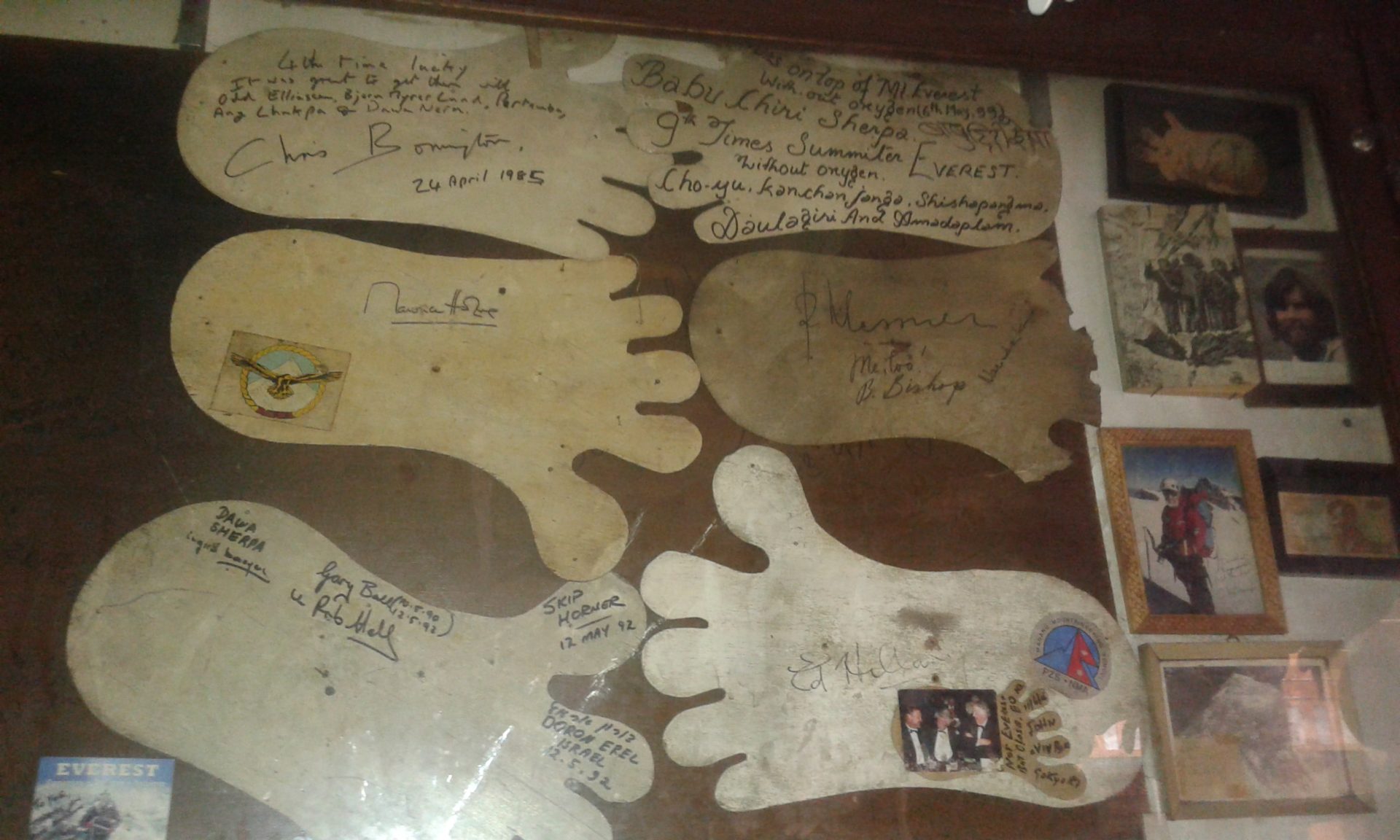
Everest Basecamp Trek 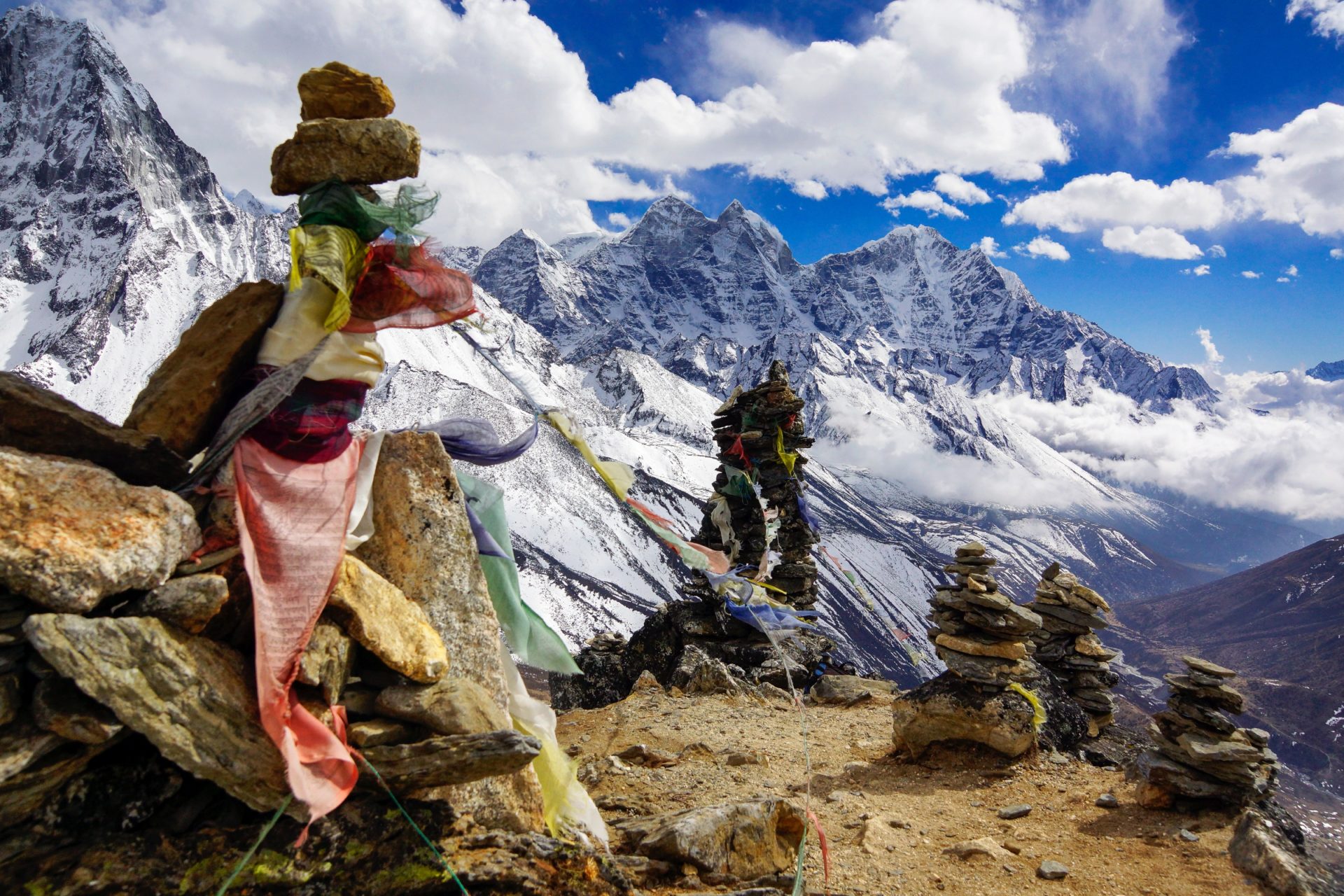
Everest Basecamp Trek 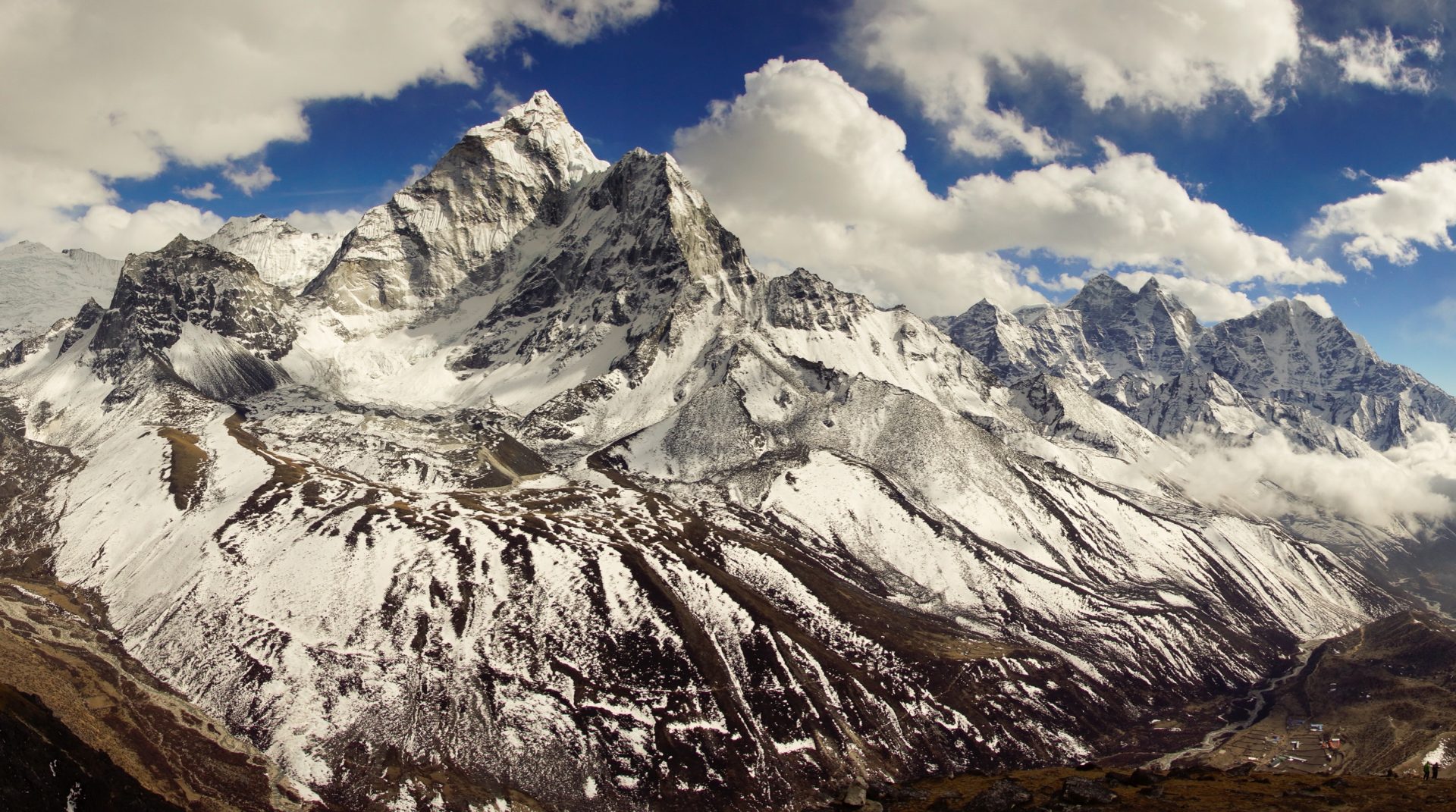
Everest Basecamp Trek 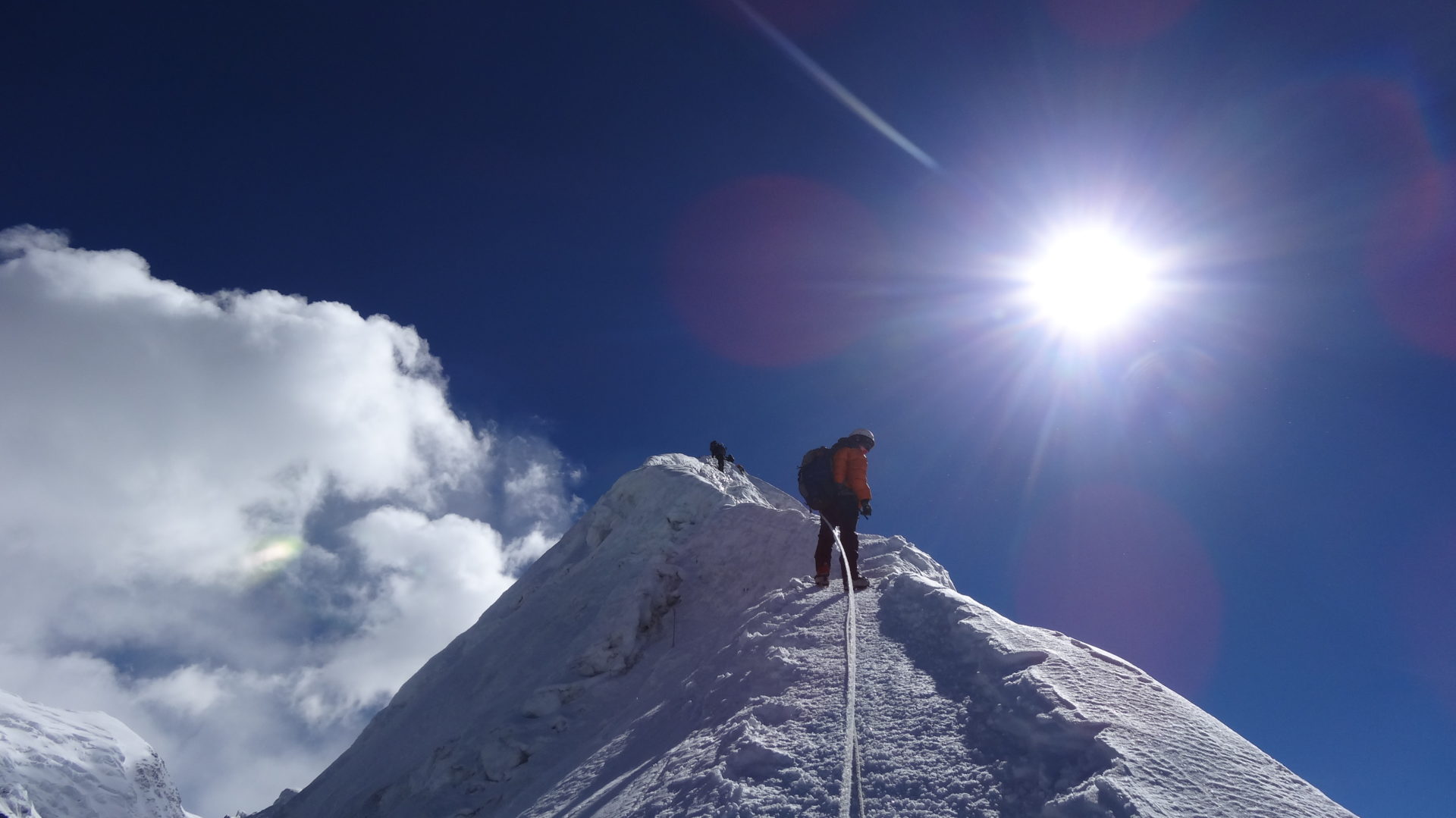
Island Peak 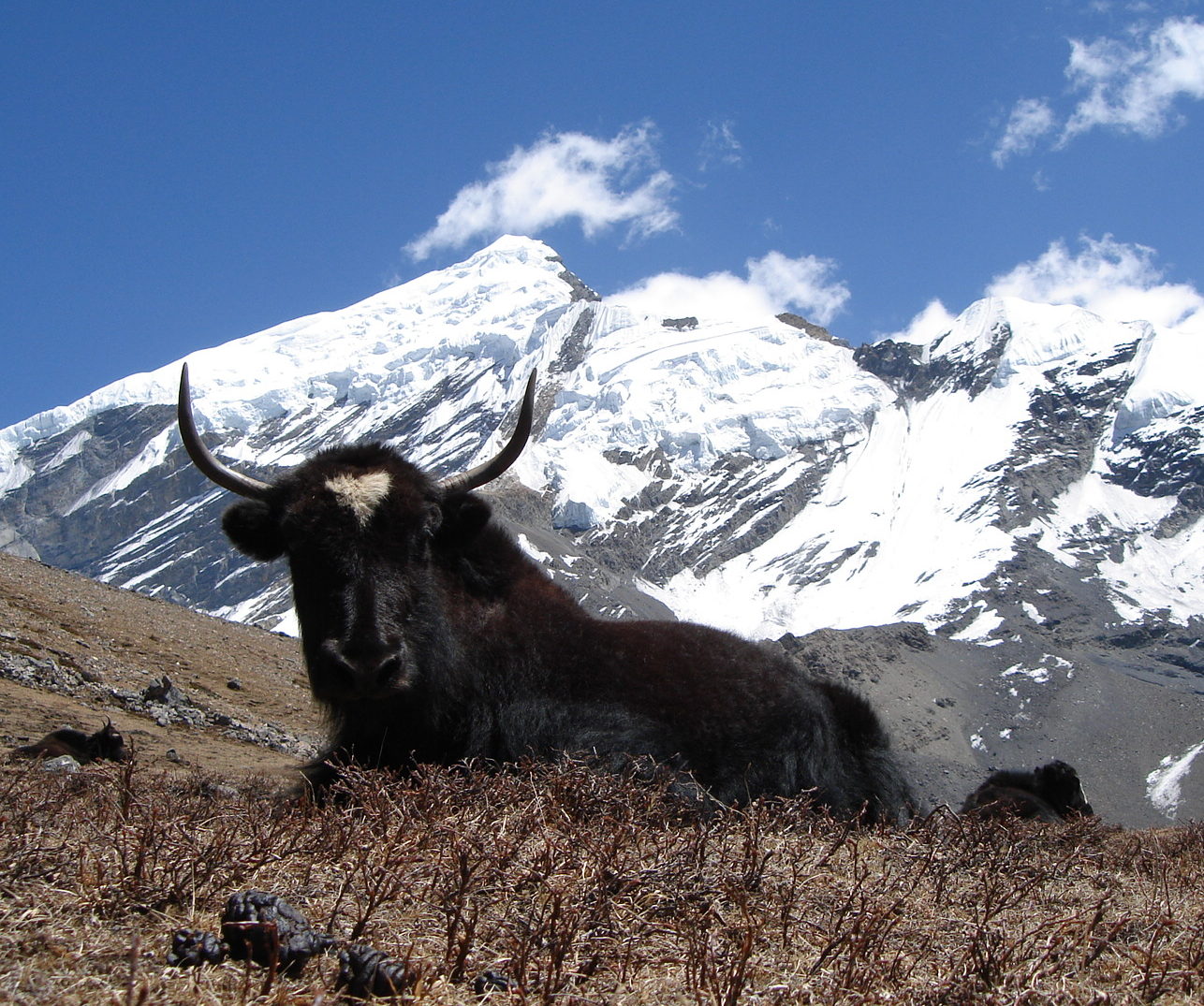
Yak 
Durbar Square 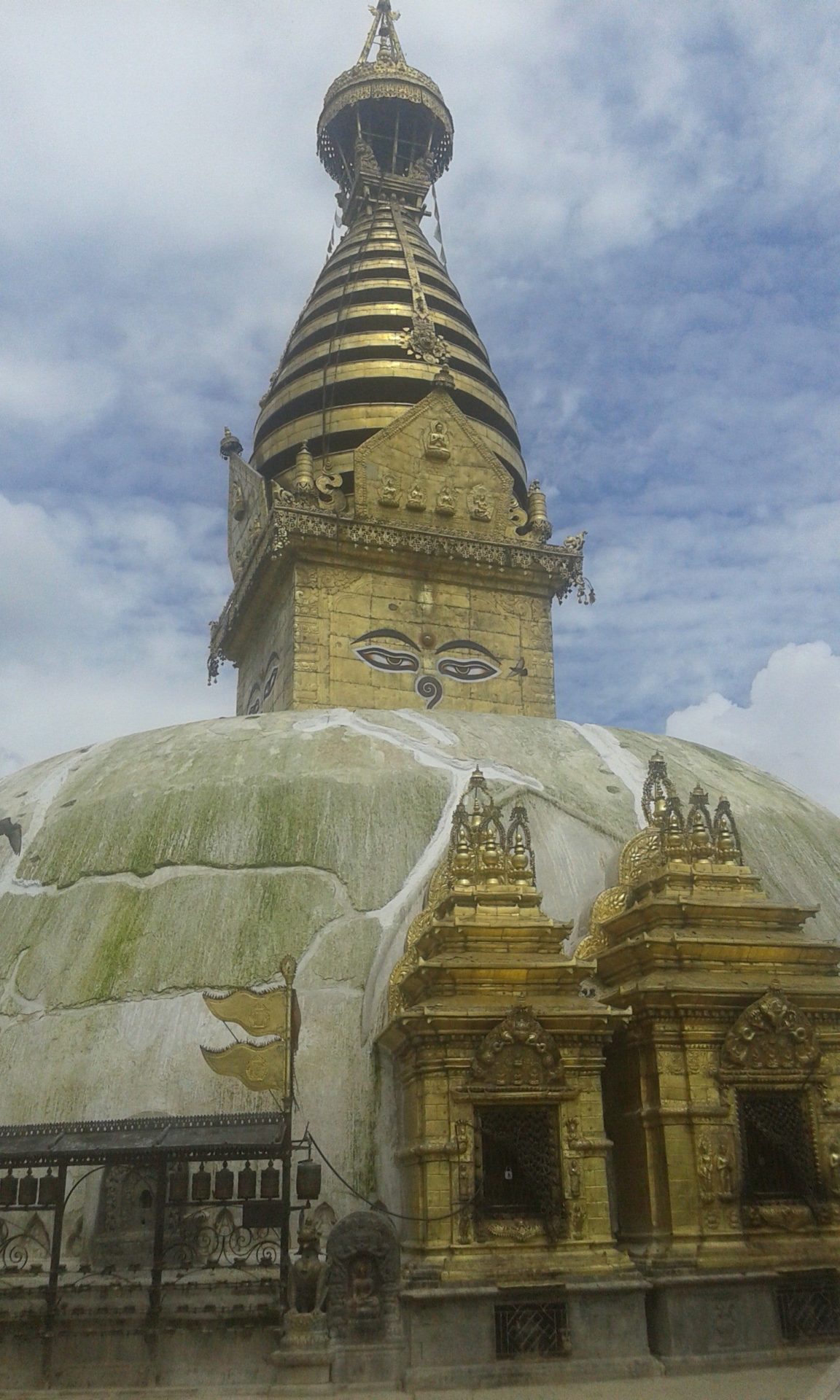
Kathmandu 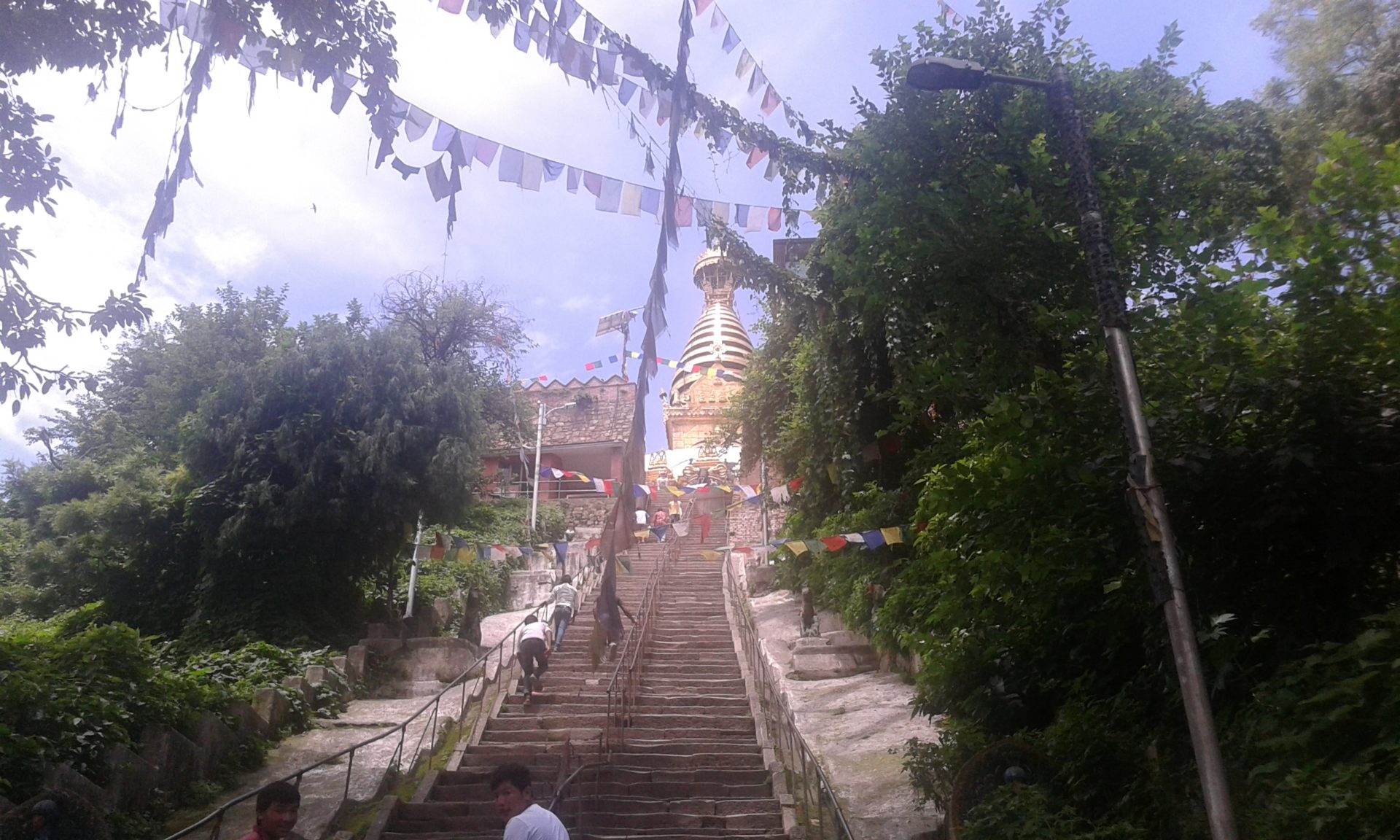
Kathmandu
Prices and Dates
Price per person from 2 participants: 2200 €
Island Peak Surcharge: 1000 €
Single room supplement 150 € for four nights in Kathmandu
Tour Info
Requirements
The Everest Base camp Trek is a challenging tour at high altitude (up to 5500 m) and extreme weather and temperature conditions. However, the stages with acclimatization days are designed in such a way that a physically fit trekker can master and enjoy the trek well.
When climbing the 6189 m high Island Peak, very good physical fitness and mental strength are required.
Further Information
- Private tour, trekking difficult
- Mount Everest Base Camp:
- Trekking: 12 days full board
- Kathmandu: 4 nights
- Maximum height: 5,545 meters
- Best travel times: March – May and Sept.- Nov.
- Option Island Peak:
- Lodge /Camping Trek: 16 days full board (22 days with arrival and departure)
- Kathmandu: 4 nights
- Maximum height: 6,189 meters
- Click here to go to the packing list
Entry requirements and permits
A passport valid for at least half a year and a tourist visa is required to enter Nepal. Visas can be applied for at the Nepalese embassy before the trip, but are also available directly upon arrival at the airport in Kathmandu. All you have to do is fill out an application form and pay a fee. The amount depends on the planned duration of the stay and the number of entries and departures into the country. It also makes sense if you bring a larger number of passport images. Although photos can also be taken in the airport in a suitable size, you will need them anyway for the trekking permits. These are required in all areas not listed in the visa itself. You will receive the trekking permits at the immigration office in Kathmandu. The fee also depends on the length of stay and the respective area. You should not try to get on the road without the right permits, as there are numerous controls in Nepal and the penalties are quite high.
Travel time
The best travel times for Nepal are the months from March to June and from September to November. During this time, the weather is usually dry and mild. The most beautiful is in autumn after the monsoon, as the air is particularly clear during this time. This is especially important if you not only want to hike, but also take impressive photos. Even in winter, the sky is often bright blue, but since the temperatures at this time of year are often below freezing and many passes are closed, only very experienced travelers should explore the country. The monsoon season in summer is rather unsuitable for trekking due to the heat and humidity.
Hygiene and health
As in most Asian countries, Nepal is not expected to have a European standard of cleanliness. You should therefore follow the usual precautions an only eat thoroughly cooked food. You should avoid raw fruit and wash your hands as thoroughly as possible before eating to reduce the risk of transmission. Water should always be boiled not only for drinking, but also for brushing your teeth, otherwise you can become infected with worms and various intestinal diseases. Vaccinations are not mandatory for Nepal, but can be meaningful individually. It is best to get advice from your doctor before travelling.
Accommodation
Even away from the capital, the network of paths in Nepal is very well developed. At regular intervals, tea houses can be found along these paths, often with attached accommodation. So you don’t necessarily have to spend the night in the wild while trekking. Since the rooms are usually not heated and bed linen is usually not provided, a sleeping bag is necessary even if you want to be accommodated exclusively in tea houses. However, hotels or guest houses in the true sense of the term are rarely found. Camping, on the other hand, is possible almost all over the country and is subject to hardly any restrictions.
During the trek you usually sleep in typical lodges, also called Guesthouse or Tea house. Lodges are comparable in function to mountain huts in the Alps. Many suppliers often speak of “strictly tested” or of “high quality standards”. Let us not fool ourselves. Lodges are simple accommodations run by their Nepalese families. Many are really very cute, others have an unbeatable view or maybe cook a good Dal Bhat.
They all have one thing in common: a lodge offers you a good place to eat and sleep.
Lodges are very simple and their construction is mostly similar. There is always a large food/common room, in the middle of which there is usually an oven. In the colder regions, of course, the most popular places are those around this oven. In these colorful oven rounds, consisting of Nepalis and trekkers from all over the world, you can make many contacts. Lodges have their very own and really interesting atmosphere
The individual rooms are always located in this common room. The rooms are almost always furnished the same. The facility consists of two beds. In the easily accessible or lower regions there is usually also light in the room. A private bathroom or shower in the room are rather rare, or only available in the main trekking areas such as in the Annapurna region from time to time.
Basically, it can be said that the higher or further away, the easier the accommodation and for the overnight stay in a lodge a sleeping bag is recommended everywhere.
Meals
During the trek you usually eat in the lodges. There is very simple but really good food. Some lodges have a reputation for certain things that are cooked particularly well there. Just ask our guides if you have an appetite for certain things.
Much is cooked with rice, pasta and potatoes. Most of the time there is everything that your own vegetable garden gives.
For allergy sufferers, eating during the trek is a real cure!
- Staples simply cooked well.
- Gluten, lactose free food
If you are allergic, you know best what gets you well. In case of doubt, you must of course ask before eating or inform your cook at tent camps.
People who suffer from lactose or gluten intolleranzen always report positively to us about the food and its tolerability during the trek.
Responsible trekking
Even in areas that are off the beaten track, pollution is now a major problem. Therefore, make sure to pack your garbage again after a rest and take it with you. Along all routes, there are always opportunities to dispose of waste of all kinds. However, you should avoid disposable packaging if possible, as the country is overwhelmed with the amount of waste generated. In addition, you should only explore Nepal with all the necessary permits and officially licensed guides, as the proceeds directly benefit the preservation of the national parks and the necessary infrastructure.
Equipment and supplies
The equipment you need depends, of course, on the travel time and the area you want to explore. The most important thing is good and suitable footwear as well as clothing adapted to the climate in sufficient numbers. A sturdy and spacious backpack and a warm sleeping bag are also included in the basic equipment. In Kathmandu, however, you can still make additional purchases without any problems, as many shops specialize in trekking travelers. You can also buy everyday items such as soap and toilet paper as well as food on site. Only on more remote routes can it be useful to take larger supplies with you.
Travel pharmacy
On the other hand, a good travel pharmacy is indispensable, which you should have with you at the time of your arrival. In any case, it includes:
- Disinfectant
- Bandages
- Insect repellent
- Sunscreen
- Cold sea
- Painkillers
- Broadband antibiotics
- Means against diarrhea
- Water disinfection tablets
Your doctor can also give you other recommendations that are tailored to your personal constitution and medical history.
Your day backpack
In a typical day pack there are usually the following things:
- Drinking bottle(s)
- Handkerchiefs (toilet)
- Camera
- Load of biscuits for the little hunger
- A fleece in case it gets cold
- If rain is to be expected, a light rain jacket
- Small first aid
Always carry along:
- Your passport
Trekking equipment up to 3,500 meters
- Backpack (day backpack)
- Shirts
- Underpants
- Two outdoor pants
- Shorts
- Two to three pairs of trekking socks
- Lightweight fleece jacket
- Thick fleece jacket
- Rain-repellent jacket with hood
- Solid pair of trekking shoes
- A pair of flip-flops / bath flaps
- Umbrella cap (Cappy) recommended
- Towel
- Telescopic poles (who likes it)
- Body care/culture bag
- Lip care pencil
- Sunscreen Factor 50
- Sunglasses
- Detergent in the tube
- LED headlamp
- Reserve batteries
- Alu or plastic drinking bottle (can also be used as a hot water bottle at night)
- Sleeping bag comfort area at +-0 zero degrees and lodge trek
- Iso mat (only for tent trek)
- 2 meters cord + 6 clothespins
- Sufficient speed handkerchiefs (toilet)
- Plastic bags for order in the backpack (dirty laundry)
- Plastic bag with Zip lock (resealable)
- Who likes to drink his own tea, tea bags
- Pharmacy
- Additional bicycle clothing
Can be purchased anywhere well in Nepal.
Don’t save on the socks
Fluffy and matching trekking socks are a very important item of equipment. In most cases, false socks are to blame for blisters and sore feet.
Multifunctional Laundry
MFW has the advantage that it dries very quickly and dissipates moisture well.
It also has a small pack size. You can wash them out after the trek and put them back on the next day.
Disadvantage:
MFW is expensive and if you don’t own any, normal T-shirts, U-pants are completely sufficient. Just take a few more with you.
Don’t save at the sleeping bag!
If you sleep well at night, you have something for the next day!
Tips
Very useful is a multifunctional towel.
Trekking equipment up to 5,500 meters
Based on trekking up to 3,500 meters
- Long underpants
- Warm hat
- Scarf
- Gloves
- Sunglasses sideways opaque (snow blindness)
- Sleeping bag comfort area at -10 degrees Lodge trek and at least -15 degrees at tent trek
- Pharmacy incl. Ams
Can be purchased anywhere well in Nepal.
Recommended vaccinations
A trip to Nepal does not require any special vaccinations. However, you should consult your Doctor about three months in advance, unless you are sure about the condition of your vaccination protection.
The following standard vaccinations should be available:
- Diphtheria
- Hepatitis A
- hepatitis B only risk groups or long-term travelers.
- Polio
- Tetanus
The (bike) trekking pharmacy
There are no pharmacies on the Trek or in the hinterland.
Most of the time you take everything for free. But – if something happens, you are happy to have a good pharmacy with you.
Our mountain guides are equipped with the most important. But you shouldn’t experiment with your own health.
It’s enough for someone from your group to take over this job. Not everyone needs the complete list.
Our recommendation:
- Painkillers
ibuprofen 600 mg. No blood thinners like aspirin. In case of injuries, the bleeding stops worse! Furthermore, ibuprofen also has an anti-inflammatory effect. - Imodium/coal tablets
- Sore throat tablets
- Remedy for abdominal pain/nausea
- Sports algae such as Diclofenac, MobilatGel etc. (high doses)
- Antibiotics (helpful but not a must)
-Amoxicillin 1000 mg in tonsils, lungs, sore throats or severe colds
-Metronidazole in margins/intestinal tract, amoeba, extreme diarrhoea
-Ciprofloxacin as a broad-spectrum antibiotic in all other inflammations. - Disinfectant or iodine ointment
- Dressings, staples, bubble patches
- Association scissors
- Sterile disposable gloves
- First aid blanket (silver foil)
Some of these medications are prescription-only and only taken as directed by the doctor. In addition to the areas of application and the dosage of the individual medications, please consult your family doctor beforehand.
He will explain exactly what to consider when administration.
Acute Mountain Sickness, altitude sickness
“Acute Mountain Sickness” does not have to be sick.
As the altitude increases, the air pressure decreases and thus also the oxygen content per cubic meter of air. At an altitude of 5,000 metres, there is only half as much oxygen in the air as at sea level.
The most important zones are:
- 0 -3,000 meters: Generally problem-free zone.
- 3,000 – 5,100 meters: Altitude problems may occur, complete acclimatization possible.
- 5,100 – 7500 meters: Only incomplete acclimatization possible. Continued decline in forces.
- over 7,500 meters: Death zone. The body consumes itself. Only short stay possible.
AMS is often the result of carelessness and misbehavior. Every body can get used to very high altitudes. You just have to give him enough time and rest.
What is AMS
Acute Mountain Sickness occurs as a result of poor acclimatization of the body to the height. It can no longer absorb enough oxygen from the air and be fed to the organism.
AMS can occur at altitudes above 3,000 meters. Most often, the condition deteriorates overnight while sleeping and the following day the typical symptoms occur:
exhaustion, severe headache in the neck area, dizziness, hallucinations, lack of sleep and appetite, vomiting, dry cough with ejection, blue lips, discolored nail beds
Ignoring the symptoms can be life-threatening.
Possible consequences:
- Hape
Occurrence: 1-3%
High lung edema. Water accumulation in the lungs. Water is pressed into the lungs by high blood pressure. - Hace
Occurrence: 1%
Altitude brain edema. Swelling of brain mass due to accumulation of fluid and dead brain cells. Rather rare. At altitudes above 3,500 meters possible, usually only from 5,000 meters.
How do I recognize AMS?
It is not easy to differentiate the beginning of AMS.
There is no point in panicking at every sign of headache or loss of appetite.
Nor is there any point in constantly trekking with fear of AMS.
- 80 percent of all climbers complain of headaches from time to time.
- It is normal to feel exhausted or uncomfortable in the stomach after a hard day with many ascents and descents.
- It can always happen that the stomach rebels due to unusual eating and drinking behavior.
- It is also normal that your performance decreases with increasing height, your resting pulse rises and you breathe much faster than on a beach holiday.
All this is normal.
But with all this you feel good and at the latest the next morning you can get started again.
AMS is best noticed, as you know yourself best. You should not hide it if your well-being deteriorates permanently over two days.
False greed according to the motto: “I’m fit, this will happen again” can end in life-threatening. Share your problems and talk about them with the group and the guide.
How do I avoid AMS?
There are a few simple rules.
- Do not ascend too fast (max. 300-500 meters per day).
- Avoid overexertion. Slow, slow is the trick
- Every 1,000 meters of altitude an additional rest day.
- Always drink a lot (no alcohol).
- Any serious disturbance is AMS unless something else has been clearly identified.
- Only continue to rise symptom-free.
Our tours are strictly planned according to these criteria.
Our mountain guides are trained in the recognition and handling of AMS.
What to do at AMS?
There is only one answer
- Descend
Immediately descend to the height, where the sick man was well for the last time.
The symptoms will subside immediately there. Overnight at this altitude and try the ascent slowly after a day or two (if the sufferer feels thereafter).
The continuation of the ascent usually leads to the worsening of the condition at the latest at the next overnight stay.
Diamox as a prophylaxis ?
Diamox (acetazolamide) reduces the internal pressure of the vessel, e.g. for treatment with too high internal pressure. The opinions of the world of specialists and doctors are sometimes different. While in the USA all doctors prescribe Diamox prophylactically during high mountain tours, in Europe this is dispensed with. There are long-term studies conducted in the Everest region in 2008. In short, Diamox helps to adjust to height. So far, I think everyone agrees.
Our experience and recommendation with Diamox is as follows:
- If no altitude sickness is known so far, do not take Diamox to get to know your own limits.
- If altitude sickness has occurred earlier, take acetazolamide from 500 meters below the last occurrence. 250mg in the morning and at noon.
- Drink a lot
When compromising your travel pharmacy, please contact your Doctor for this.
Basic knowledge for tours over 6,000 meters
In extreme high altitude, everyone should be well informed about AMS. After all, there is a possibility that your mountaineer will fall ill. The following information can only be referred to as the Crash Course AMS and you should in any case have a detailed conversation with your doctor in advance.
Measures at actual AMS
If it is not possible to transport to deeper regions immediately or only the next morning and the following symptoms already occur:
- Extreme shortness of breath with the lowest load
- strong cough or cough mixed with secretion, bloody in extreme case
- Rattle noises in the lungs
- Pulse over 120 at rest
- Headaches do not react to painkillers, get worse when lying down
- Severe headache from the neck area
- Transition to unconsciousness
Attention danger to life!
Emergency medication combination HAPE/HACE:
- Immediately down to min. 1,000 meters.
- Dexamethasone (Fortecortin 4 mg, initial 2 tablets, then every 6-8 hours each 1 tablet.
- Nifedipine retard 20 mg immediately and then, if necessary, every 6 hours.
- Acetazolamide 2 x 250 mg initial (or 1 x 500 mg retard). Then every 6-8 hours each 250 mg.
Proper behaviour as a helper:
- Fight against panic in the patient.
- Keep patients warm.
- Immediately at min. Evacuate 1,000 meters deeper.
- Transport lying with slightly raised head.
- Administer oxygen.
The medication only gives you the time to take the patient to deeper regions. It is not used to make the patient symptom-free and to enable him to continue to climb or stay in the height.
Please consult your Doctor on the compilation of your travel pharmacy.
How many rupees?
With the credit card you can pay very well in Kathmandu and Pokhara.
- The official means of payment in Nepal is the Nepalese Rupee (NPR).
- In recent years, the rule of thumb 100 NRP has been around 1 euro.
- You can find the current conversion rate here
What do I take with me ?
Our recommendation is as follows:
- Your debit card with secret number
- A credit card
- A little euro cash in case of need (250.00 Euro)
Get money
Tip: Nabil-Bank (green-white logo) – withdrawal up to 30,000,00 rupees possible!
In big cities like Kathmandu, you get money everywhere with your debit card + secret number (as in Germany). It should be noted that many banks only allow withdrawals every 24h to 100.00 euros. This is not enough for the holiday fund. An exception is the Nabil Bank, which allows withdrawals up to just under EUR 300.00.
The courses at ATM machines are currently good and up-to-date. Lift off “sufficient” than several times little. In most cases, the banks charge you a minimum fee per withdrawal. This is about 5.00 euros.
Whether the ATM gives you money with your debit card, you can tell by the fact that a MAESTRO sticker is attached.
If you have a credit card such as Mastercard, Visa etc. with secret number, you can also use it for cash withdrawals at the ATM. About the fees for cash withdrawals with an EC or credit card, ask a banker of your trust beforehand ?
Euro cash can always be exchanged at various exchange offices. Again, the fee is usually higher than for the ATM with debit card. You can compare when you’re there.
Note on credit and debit cards
In any case, we recommend that you check with your bank before leaving if your card is activated abroad (not Europe) and what the limit for cash withdrawals is.
Take money back
Running NPR is not allowed.
It also does not exchange you a bank in Germany.
Either you spend everything in Nepal or exchange it back in Nepal in Euros.
Money trekking/ mountain biking
In the hinterland there is hardly any possibility to get fresh money. You should take enough money with you in advance, e.g. from Kathmandu. Cash like euros can also be exchanged in the mountains, but the price is usually not so sparkling.
Our experience is that you spend almost no money on the trek. Our tours are incl. three meals a day + overnight free. All you need is money for:
- Coke, water, fanta, etc.
- Candy
- Possibly a small errand
As a guideline, you can say that 15.00 to 20.00 Euro per day and nose are enough on our tours. If there is something left afterwards, it can be spent wonderfully in e.g. in Kathmandu or Pokhara.
You should also take a reserve as emergency money in euros.
Negotiate
When shopping in Nepal, it should always be well negotiated beforehand.
As in almost all countries, prices in Nepal are not fixed.
It is recommended never to accept the first prize. The exception is: supermarkets, restaurants and everything official.
With all other offers you should always negotiate.
Nepal is a country of extremes
Every trip in Nepal is a little adventure. For this reason, we are making some demands on you. Please read the following text first.
Tour programs
Due to adverse circumstances – e.g. closures of sightseeing objects, holidays, bad weather, the health of the participants or unfavourable conditions during trekking, etc., route changes, program changes or delays may occur.
Of course, we and your tour guide will always strive to reach all program items to your full satisfaction. However, we cannot guarantee that our tenders will be adhered to accurately. We ask for your understanding.
Construction
In Kathmandu, especially in the district of Thamel, construction is always underway. Construction site noise and disturbances in the city are the order of the day. Since the local planning is quite spontaneous, we cannot guarantee that the hotels we have booked will not be affected.
Please inform yourself about your destination and what to expect on the spot before travelling.
Flying in Nepal
The domestic flights booked by us are operated with the following airlines:
- Yeti, Tara Air
- Agni Air
- Sita Air
- Nepal Air
- Simrik Air
- Goma Air
- Buddha Air
Domestic flights in Nepal may be postponed by days due to limited air space capacity, weather conditions, technical or other reasons. In the past, some domestic airports in Nepal have been closed for several days. In these exceptional cases, we will try, with your cooperation, to move the tour to other regions or to organize the transport by land. The risk of delay and failure of these flights is at the expense of all participants.
In the event of delays lasting several days, all participants are responsible for re-booking their return flight to their home country at least 48 hours in advance. Of course, we are at your disposal with our help.
Behavior Trekking/Mountain Biking
Trekking in Nepal should always require a certain physical fitness and a good state of health. We also expect:
- Independent and self-responsible action even in extreme situations.
- Comradely behavior.
- Tolerance and helpfulness towards the group and the Nepalese team.
You should be able to walk independently and safely over difficult terrain, e.g. boulders, moraine debris, glaciers covered with debris and ice, even in bad weather.
In addition, the tour guide is authorized to send participants back if their behavior threatens the community or even the company itself or if they are not able to cope with the demands psychologically or physically.
Mountaineering, on expeditions
When mountaineering (peak climbing, expeditions) you should also be able to walk independently and independently in a rope. Alpine technical skills are indispensable. Glacier and ice experience should be available. In addition to a very good condition or health, you should also have a certain mental strength.
Paying the travel price does not include a right to a summit attempt/success.
Every participant should be aware that trekking in Nepal involves unpredictable subjective and objective dangers and that the rescue possibilities at high altitudes are very limited.
Each participant participates independently and at his own risk in our tours.


